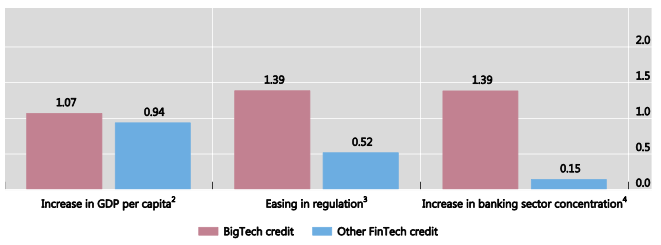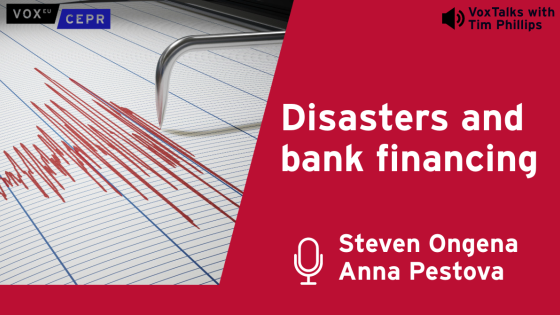Big Tech firms – large technology firms whose primary business is digital services – are entering finance (Zetzsche et al. 2017, Carstens 2018). Facebook’s Libra proposal is just one recent example of a much broader trend. In China, Big Tech firms like Ant Financial and Tencent offer a range of financial services (Xie et al. 2018, Luohan Academy Report 2019) and this is being seen increasingly in other markets, particularly in other parts of Asia, East Africa, and Latin America. The entry of these firms into finance has usually started with payments. After that, many have followed a well-worn path of broadening their activities into the provision of credit, insurance, and toward savings products, either directly or in partnership with incumbent financial institutions.
The main advantage of Big Tech firms is their ability to exploit their existing networks and the massive quantities of data generated by their existing business lines. Their entry raises a number of important questions. For instance, what are the economic forces that best explain the adoption of Big Tech services in finance? Do Big Tech lenders have an information advantage from their access to users’ data or from technological advantages arising from innovations in processing methods, particularly in relation to credit scoring?
Drivers of Big Tech entry into credit markets
Our new research (Frost et al. 2019) addresses these questions. It shows that FinTech firms extend less than 1% of global private sector credit, but their footprint is growing (Figure 1). In a number of countries in Asia, Latin America, Europe, and North America, Big Tech firms now lend to millions of small and medium firms.
Figure 1 Global volume of new Big Tech and other FinTech credit
Note: The bars indicate annual global lending flows by Big Tech and other FinTech firms over 2013-2017. Figure includes estimates. 1 Total FinTech credit is defined as the sum of the flow of Big Tech and other FinTech credit. This is then divided by the stock of total credit to the private non-financial sector. 2 Calculated for countries for which data were available for 2013–2017.
Sources: Cambridge Centre for Alternative Finance and research partners, Big Tech companies’ financial statements, authors’ calculations.
Big Tech firms differ from banks in at least two key ways. First, they have a loyal client base in users of their e-commerce platforms, messaging services, or search engine. Second, they use advanced technology, for example artificial intelligence, to parse massive volumes of data. Big Tech lenders can exploit the data generated by their networks and machine learning to tailor prices and distribute financial services. Credit and other services are typically provided without human intervention.
Using data on FinTech credit from the Cambridge Centre for Alternative Finance (Rau 2017, Claessens et al. 2018) and hand-collected data on large technological firms, we construct a unique dataset that includes Big Tech credit as an additional category in the broader universe of FinTech credit. We find that the differences in the development of total FinTech credit reflect differences in income and financial market structure – the higher a country's income and the less competitive its banking system, the larger the FinTech credit activity. Big Tech credit benefits even more from these factors (Figure 2).
Figure 2 Drivers of Big Tech and other FinTech credit volumes across jurisdictions
Note: The bars visualise the estimated change in Big Tech and other FinTech credit volumes from a change in the respective variables, based on the estimated coefficients displayed in the fifth column of Table 3. 1 Change in Big Tech credit and other FinTech credit per capita given a one-standard deviation change in the selected variables. 2 Nominal GDP in USD over total population. Given the non-linearity of the relationship, the change is calculated at the average GDP per capita level. 3 Regulatory stringency is constructed as an index based on the World Bank’s Bank Regulation and Supervision Survey. The index takes a value between 0 (least stringent) and 1 (most stringent) based on 18 questions about bank capital requirements, the legal powers of supervisory agencies, etc. 4 One-standard deviation increase in the banking Sector Lerner index (an indicator of bank mark-ups and hence market power).
Source: Authors’ calculations.
Big Tech credit assessment: Big data and artificial intelligence
However, in order to better understand more specific drivers, including the competitive and comparative advantages of Big Tech, it is necessary to understand the lending model in more detail. In particular, we need to understand how lending decisions based on machine learning and the processing of large quantities of information (big data) alter credit assessment. Using data from Mercado Libre, and its lending product Mercado Crédito, we compare the defaults of firms based on their credit score with machine learning and big data from the e-commerce platform (‘internal rating’) and a traditional credit bureau score (Figure 3, left panel). To date, the internal rating has been superior to the credit bureau in predicting defaults (Figure 3, right panel). However, the jury is still out. Any judgement on the ability of Big Tech credit scoring to better pinpoint creditworthiness should be based on a complete cycle, evaluating the probability of default in stress situations.
Figure 3 Loss rates by internal ratings of Mercado Libre versus credit bureau
Note: 1 The loss rate is the volume of loans more than 30 days past due relative to the origination volume. In its use to date, the internal rating of Mercado Libre is better able to predict such losses. It segments the originations into five different risk groups as compared to the three clusters identified by the credit bureau. The size of the dots is proportional to the share of the firms in the rating distribution. 2 True positive rates versus false positive rates for borrowers at different thresholds for a logistic model with only the credit bureau score (I), a logistic model with the bureau score and borrowers’ characteristics (II), and a machine learning model with the Mercado Libre credit score (III). A random model is included for comparison purposes. The ROC curve shows that the machine learning model has superior predictive power to both the credit bureau score only and the credit bureau score with borrower characteristics.
Source: authors’ calculations based on Mercado Libre data.
Conclusions
The rapid growth of Big Tech in finance will bring both benefits and risks to the future banking system. Big Tech firms may enhance competition and financial inclusion and contribute to the efficiency of financial services. Conversely, such firms may further concentrate market power or give rise to new systemic risks (BIS 2019). Overall, it is important to understand how Big Tech firms fit within the current framework of financial regulation, and under which principles regulation should be organised. All these are relevant aspects for future research in this area.
References
Bank for International Settlements (2019), Big tech in finance: opportunities and risks, Annual Economic Report, June.
Carstens, A (2018), “Big tech in finance and new challenges for public policy”, speech to FT Banking Summit, 2 December.
Claessens, S, J Frost, G Turner, and F Zhu (2018), “Fintech credit markets around the world: size, drivers and policy issues”, BIS Quarterly Review, September.
Frost, J, L Gambacorta Y Huang, H S Shin, and P Zbinden (2019), “BigTech and the Changing Structure of Financial Intermediation”, BIS Working Paper no. 779.
Luohan Academy Report (2019), Digital Technology and Inclusive Growth, Hangzhou.
Rau, R (2017), “Law, trust, and the development of crowdfunding”, University of Cambridge Working Paper.
Xie, P, C Zou, and H Liu (2018), “The fundamentals of internet finance and its policy implications in China”, China Economic Journal 9(3): 240–252.
Zetzsche, D, R Buckley, D Arner, and J Barberis (2017), “From FinTech to TechFin: The Regulatory Challenges of Data-Driven Finance”, New York University Journal of Law and Business.












